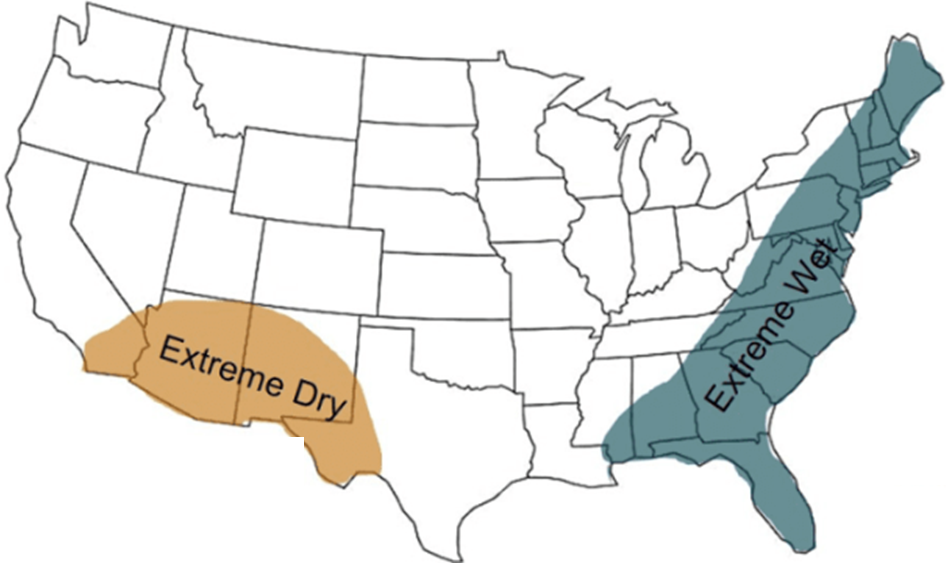ENSO Analysis Points to Increases in Severe U.S. Drought and Floods Through 2050
April 14, 2025

Schematic of future changes in the regional U.S. extreme hydroclimate events: Extreme wet events show higher frequency due to the impact of more intense El Nino activity. Extreme dry events show increased frequency in the Southwest desert due to projected higher magnitude La Nina events. Credit: Hong et al. (2025, npj Climate & Atmospheric Science)
People's lives and property and the Earth's natural resources are threatened by extreme weather, whose associated economic impacts can be far-reaching. Too much or not enough rain in one area can affect the economic sector by modifying agriculture production, water management, transportation routes, and business operations across the nation and beyond.
Understanding the drivers of extreme weather to improve predictions and develop mitigation strategies is a key focus of climate research. Scientists are particularly interested in the El Nino-Southern Oscillation (ENSO) – a naturally occurring central Pacific climate driver that affects global atmospheric circulation – because it can be used to predict impacts on United States (U.S.) extreme weather many months in advance in some cases.
Recently, scientists performed a comprehensive analysis of historical and projected future droughts and floods across the entire U.S. to better understand the relationship between ENSO and extreme hydroclimate (water and weather) events. The authors – a team of scientists from two National Oceanic and Atmospheric Administration (NOAA) Cooperative Institutes and the NOAA Geophysical Fluid Dynamic Laboratory – published their results
Projected increase in ENSO-induced US winter extreme hydroclimate events in SPEAR large ensemble simulation in Nature Partner Journals Climate and Atmospheric Science.
"Based on current trends, we expect that the strength of ENSO's phases will increase in the future, bringing potential increases in extreme precipitation," explained Andrew Mercer, an atmospheric scientist with the Northern Gulf Institute and Professor of Meteorology at Mississippi State University's Department of Geosciences. "Our analysis shows that as a result of more extreme ENSO events, droughts could get drier and last longer, and periods of extreme rainfall will likely include greater rainfall excesses."
The analysis revealed that the U.S. is projected to experience an increase in extreme wet events during winter (December-February) through 2050 and then decreasing afterward. The areas projected to experience a remarkable increase in extreme wet events included the Southeast, Northeast, and Great Plains; extreme drought is projected to become more common as well, particularly in the Southwest.
To understand past associations between ENSO and extreme U.S. winter precipitation, the authors used historical observations of U.S. precipitation, wind, and atmospheric pressure (datasets were linearly detrended to remove any biases related to observed recent climate shifts) in hindcast simulations. These hindcast simulations were used to further dissect simulations of future extremes in U.S. precipitation induced by ENSO as well as other atmospheric effects. The team utilized a state-of-the-art seasonal forecast model, the Seamless System for Prediction and Earth System Research Large Ensemble Simulation (SPEAR-LENS) and decomposed the precipitation into ENSO-forced and non-ENSO-forced precipitation using linear regression for two 50-year period simulations – a historical period from 1931 to 1980 and a future period from 2031 to 2080.
Results indicated that ENSO-driven precipitation variance (influenced by deviations from typical sea surface temperature and atmospheric pressure in the Pacific Ocean) steadily increased during the past decades and that historical increases in year-to-year variations of U.S. winter precipitation were induced by ENSO. Projections indicated an increasing impact from ENSO on U.S. extreme precipitation in winter as well as ENSO-induced atmospheric effects worldwide through the 21st century.
Mercer noted that while ENSO is one of several drivers of large-scale variability in precipitation, it is estimated to be a prominent driver. "Not all ENSO events will result in greater extremes; however, we expect the maximum and minimum values of precipitation driven by ENSO to become more pronounced as time progresses."
What's next for this research? Mercer said their team will use these results, which are based on historic ENSO events, to determine more detailed expectations for future droughts and flooding and gain better insight into the longer-term impacts of ENSO on the hydroclimate. Plans for targeted modeling studies and analysis will seek to better understand the relative roles of future changes in ENSO, the atmospheric background state, and extremes in U.S. precipitation and hydroclimate events.
The study's authors are Jin-Sil Hong, Dongmin Kim, Hosmay Lopez, Sang-Ki Lee, Andrew Mercer, and Nathaniel C. Johnson.
Learn more about the Earth's most influential climate phenomena in this NOAA video
Understanding El Nino and articles
El Nino and La Nina: Frequently asked questions and
50 years of getting ENSO predictions *mostly* correct.

Composite maps of the probability (%) for future periods of extreme wet events during El Nino and extreme dry events during La Nina.
Credit: Hong et al. (2025, npj Climate & Atmospheric Science)
**********
The NOAA
Geophysical Fluid Dynamic Laboratory has state-of-the-art coupled global Earth system models that provide a suite of societally relevant information and decision support products from weather to climate time scales, and on geographic scales, from local to global.
The NOAA
Cooperative Institute for Marine and Atmospheric Studies is based at the University of Miami Rosenstiel School of Marine, Atmospheric, and Earth Science and brings together research and educational resources to increase scientific understanding of Earth's oceans and atmosphere.
The
Northern Gulf Institute is a NOAA Cooperative Institute with six academic institutions located across the U.S. Gulf Coast states that conducts research and outreach on the interconnections among Gulf ecosystems for informed decision making.
Article by
Nilde Maggie Dannreuther and
Andrew Mercer with the Northern Gulf Institute at Mississippi State University.

